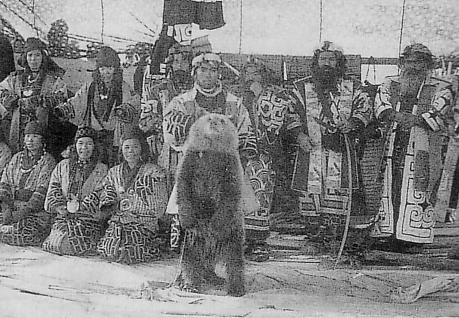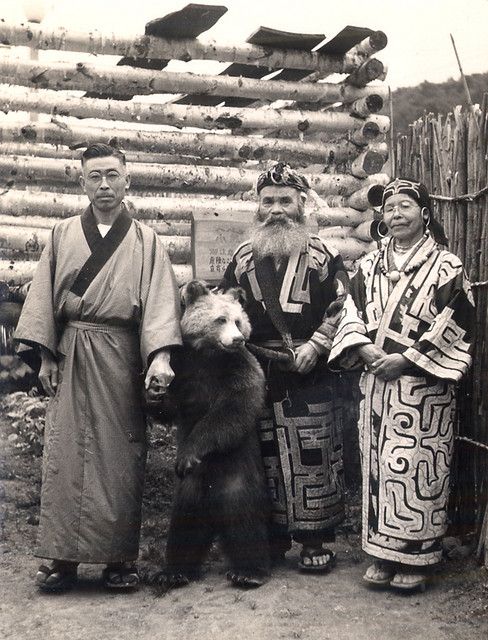In the section below of Isabella Bird’s account of the Ainu (Unbeaten Tracks in Japan, p. 275), she deals with the most famous aspect of the religion – the cult of the bear. Most people today think of the Ainu as a bear-worshipping tribe who are hairier than the typical Japanese. It’s also supposed that because they ‘worship’ the bear, they have some kind of close relationship, though as Green Shinto has noted on previous occasions, the treatment of bears can be extremely cruel and involves blood sacrifice. (See here for the release of museum bears, for which Green Shinto campaigned.)
*********************

Bird writes,…
The peculiarity which distinguishes the rude mythology is the ‘worship’ of the bear, the Yezo bear being one of the finest of his species; but it is impossible to understand the feelings by which it is prompted, for they worship it after their fashion, and set up its head in their villages, yet they trap it, kill it, eat it and sell its skin. There is no doubt that this wild beast inspires more of the feeling which prompts worship than the inanimate forces of nature, and the Ainus may be distinguished as bear-worshippers, and their greatest religious festival or Saturnalia as the Festival of the Bear. Gentle and peaceable as they are, they have a great admiration for fierceness and courage; and the bear, which is the strongest, fiercest, and most courageous animal known to them, has probably in all ages inspired them with veneration. Some of their rude chants are in praise of the bear, and their highest eulogy on a man is to compare him to a bear. (…)
In all Ainu villages, specially near the chief’s house, there are several tall poles with the fleshless skull of a bear on the top of each, and in most there is also a large cage, made grid-iron fashion, of stout timbers, and raised two or three feet from the ground. At the present time such cages contain young but well-grown bears, captured when quite small in the early spring. After the capture the bear cub is introduced into a dwelling house, generally that of the chief, or sub-chief, where it is suckled by a woman, and played with by the children, till it grows too big and rough for domestic ways and is placed in a strong cage, in which it is fed and cared for, as I understand, till the autumn of the following year, when, being strong and well-grown, the Festival of the Bear is celebrated. The customs of this festival vary considerably and the manner of the bear’s death differs among the mountain and coast Ainus, but everywhere there is a general gathering of the people, and it is the occasion of a great feast, accompanied with much saké and a curious dance, in which men alone take part.
Yells and shouts are used to excite the bear, and he becomes much agitated a chief shoots him an arrow inflicting a slight wound which maddens him, on which the bars of the cage are raised, and he springs forth, very furious. At this stage the Ainus run upon him with various weapons, each one striving to inflict a wound, as it brings good luck to draw his blood. As soon as he falls down exhausted, his head is cut off, and the weapons with which he has been wounded are offered to it, and he is asked to avenge himself upon them. Afterwards the carcass, amidst a frenzied uproar, is distributed among the people, and amidst feasting and riot the head, placed upon a pole, is worshipped i.e. it receives libations of saké, and festival closes with general intoxication. In some villages it is customary for the foster-mother of the bear to utter piercing wails while he is delivered to his murderers, and after he is slain to beat each one of them with a branch of a tree.

***************
For Part One of this series, please click here.
For an excellent 28 minute documentary made in the 1930s of the Ainu Bear Festival (Iyomande/Iomante), please see here. It shows how the Bear Spirit made incarnate in an individual bear is released to join its maker by ritual killing. After the sending off ceremony, there is celebration with dance, song and saké in the hope of being blessed with more bear hunting in the coming year. Interestingly this revelry takes place in mid-winter, season of death and rebirth celebrated throughout the northern hemisphere with frolics and feasting.

Leave a Reply